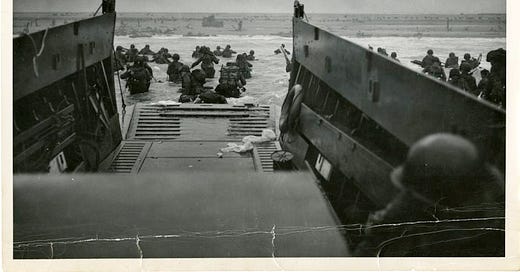The Story Behind Robert F. Sargent's Famous Photograph "Taxis to Hell – and Back – Into the Jaws of Death"
After sharing this photograph on social media with the title "Anti-fascists disrupt a white supremacist gathering," I was intrigued by the photo and felt compelled to delve deeper into the story
The photograph titled "Taxis to Hell – and Back – Into the Jaws of Death" encapsulates a moment of great courage and selflessness during one of the most pivotal events of the 20th century. Taken on June 6, 1944, known as D-Day, during the Allied invasion of Normandy, the picture depicts a group of American soldiers as they storm the beaches of Omaha under heavy German fire.
The photographer, Robert F. Sargent, was a member of the United States Coast Guard assigned to document the invasion. He and his camera crew landed on the beach with the first wave of troops. The soldiers in the photograph were members of the 16th Infantry Regiment of the 1st Infantry Division, nicknamed the "Big Red One," tasked with securing a stretch of beach codenamed "Easy Red."
As they made their way forward, they were met with intense fire from German machine guns and artillery. This battle, codenamed Neptune, was the largest combat operation ever performed by the United States Coast Guard.
The phrase "into the jaws of Death" in the photograph's title comes from a refrain in "The Charge of the Light Brigade," a narrative poem by Alfred, Lord Tennyson about the Charge of the Light Brigade during the Crimean War.
Sargent and his fellow soldiers experienced a tumultuous journey. The amphibious tanks were swamping off the beaches, making the journey even more perilous. The soldiers endured the bitter cold and drenching waves that constantly broke over the vessel. As they approached Omaha Beach, the incoming tide and the German obstacles, which were meant to hinder the Allied invasion, were visible. Sargent observed a disabled amphibious tank and another landing craft that had broached along the beach, just as their landing craft was preparing to lower the bow ramp. Despite the German artillery targeting their landing craft, they managed to discharge all the troops into chest-deep water without any casualties. However, he also witnessed another landing craft positioned close to their port side, which was not as fortunate.
The invasion of Normandy was one of the deadliest battles of World War II. Over 156,000 American, British, and Canadian troops landed on the beaches of Normandy on June 6, 1944, and faced heavy German resistance. By the end of the day, over 4,000 Allied soldiers had been killed or wounded. The battle marked the beginning of the end of the war in Europe, but it came at a tremendous cost to human lives.
The power of the photograph lies in its ability to capture not only the bravery of the soldiers but also the scale of the sacrifice that they were making. The soldiers knew that they were running into a hail of gunfire, aware that many of them would not make it to the other side. However, they continued because they believed in the cause. They were ordinary men thrust into an extraordinary situation, and their bravery and chilling sacrifice are palpable in every pixel of the photograph.
As we reflect on the events of World War II, it is essential to remember the sacrifices made by those who fought and died in the fight against fascism and tyranny. "Into the Jaws of Death" is a powerful reminder of the cost of war and the bravery and sacrifice of those who fought for freedom and justice. It remains a potent symbol of the human experience of war and a testament to the power of photography to capture history and emotion in a single frame.




